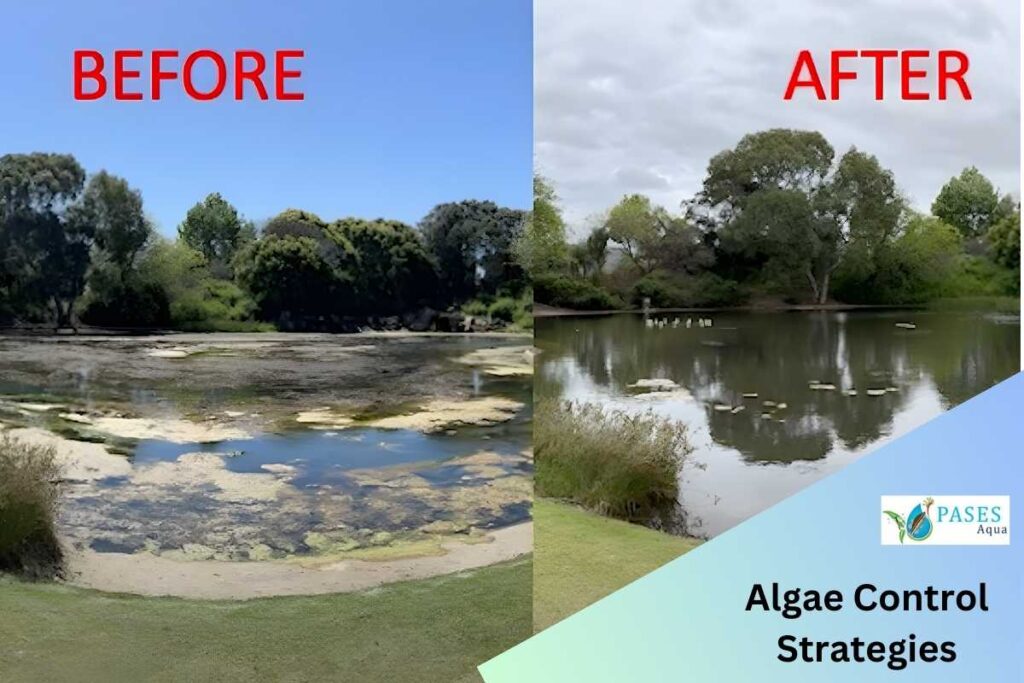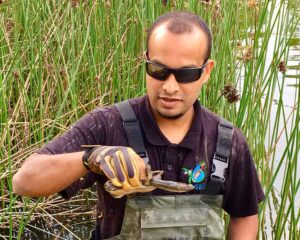Algae in dams can be an unsightly and persistent problem, affecting water quality and the overall health of the aquatic ecosystem. If your dam is besieged by an overgrowth of algae, understanding the causes and exploring effective solutions is crucial for restoring its balance. Algae blooms can be triggered by an excess of nutrients in the water, such as nitrogen and phosphorus, often due to runoff from urban gardens ( fertilisers) and nearby agriculture or the decomposition of organic matter within the dam itself.
Managing algae is about eradication and striking the right balance in your dam’s ecosystem. Various methods can be employed to keep algae in check, ranging from manual removal to biological control, such as encouraging the growth of beneficial bacteria. Aeration is a crucial strategy, adding oxygen to the water to promote the health of aerobic bacteria, which in turn compete with algae for nutrients. Adhering to best practices in dam management will help maintain water quality and prevent the conditions that favour excessive algae growth.
Key Takeaways
- Algae management requires understanding the factors that contribute to blooms.
- A variety of methods are available for controlling algae in dams.
- Maintaining a balanced ecosystem in your dam is essential for ongoing algae management.
- Aeration is a crucial strategy to promote the health of aerobic bacteria, which in turn compete with algae for nutrients
Recommended aeration systems based on dam size.
For Small dams
SUBAIR Aeration Kit 1
Matala MEA Lake Pro 1 Kit
For Mid-size dams
SUBAIR Aeration Kit 2
Matala MEA Lake Pro 2 Kit
For Large dams
SUBAIR Aeration Kit 3
Matala MEA Lake Pro 3 Kit
How to install lake bed aeration systems:

How to treat filamentous algae in dams & lakes – By Dr. Dulana Herath (Or Dean) from PASES Aqua

Understanding Algae in Dams
In your quest to maintain a healthy dam, recognising the various algae types is crucial. Each kind of algae has different characteristics and requires specific approaches for control.
Types of Algae
Planktonic Algae: Usually appearing as a colour change in the water – often green or brown – planktonic algae consist of microscopic organisms that float throughout the water. They are a normal part of a dam’s fauna in small amounts, but large blooms can decrease oxygen levels, which is detrimental to fish and other aquatic life.hours.
Blue-Green Algae (Cyanobacteria): Despite the name, blue-green algae are bacteria that photosynthesise. They can form harmful blooms that may produce toxins, posing human and animal health risks. Blooms typically give the water a blue-green appearance and can cause odours.
Filamentous Algae: Often found forming dense mats, filamentous algae consist of long chains of cells that weave together. These algae types are commonly found on the edges or bottom of a dam and can feel slimy to the touch.
Algae In Microscope
Factors Contributing to Algal Growth
Algae in your dam can be a nuisance, but understanding the factors contributing to their proliferation is crucial. Controlling these elements can significantly curtail algal blooms.
Nutrients and Water Conditions
Nutrients: Algal growth is often fuelled by two key elements: phosphorus and nitrogen. These nutrients can enter your dam from various sources, such as fertiliser runoff or decomposing organic matter. Monitoring and managing these nutrient levels is essential to keep algae in check.
Phosphorus: Particularly influential in freshwater systems, even low levels can promote excessive algal growth.
- Nitrogen: Often in abundant supply, but controlling its levels can still effectively reduce algal blooms.
Water Conditions: The quality of water is equally significant. Dissolved oxygen levels fluctuate with the presence of algae, as they produce oxygen during the day but consume it at night, which could harm aquatic life. Maintaining a stable ecosystem involves:
- Regular testing and management of water quality
- Control of external nutrient input
Light and Temperature
Light: Algae require sunlight for photosynthesis. Excessive light, especially during long sunny days, accelerates algal growth. Reducing sunlight penetration through surface covers can be beneficial.
Temperature: Warmer water temperatures tend to favour most algae species, with blooms typically occurring in the warmer months. Cooler temperatures slow down growth, so seasonal management strategies are pivotal.
- Water Temperatures: Regular monitoring will inform you of the potential risk for algal blooms and enable you to take timely action.
By understanding and managing these factors, you can better control algal growth in your dam and maintain a healthy aquatic ecosystem.
Algae Control Methods
Effectively managing algae in your dam requires a multi-faceted approach that may include mechanical removal, chemical treatments, and biological solutions. These methods aim to restore and maintain the ecological balance of your aquatic ecosystem.
Mechanical and Environmental Adjustments
Aeration is a crucial strategy that enhances oxygen levels in the water, promoting the growth of beneficial bacteria and disrupting the environment algae require to thrive. For instance, installing an aeration device can facilitate this process, helping to break down excess nutrients, often the leading cause of algae blooms.
Adjustments to your dam environment can also significantly impact algae control. Introducing aquatic plants can create shade and compete for nutrients, inhibiting algae growth. Additionally, regularly removing any sludge build-up manually or through dredging can prevent the decaying matter from feeding new algae blooms.
Chemical Treatments
Using chemical algaecides, like coptrol or commercial products, such as Algaelift, effectively controls excessive algae. However, applying these treatments following the manufacturer’s guidelines is crucial to avoid harming the dam’s aquatic life. Herbicides may be necessary for severe cases, but they should always be used as a last resort due to potential risks to non-target species.
Periodic application of barley straw has shown to gradually minimise algae presence as it decomposes, releasing compounds that can suppress algae growth.
Biological Solutions
Biological treatments involve introducing beneficial bacteria and enzymes to outcompete algae for nutrients. These probiotics can also help break down organic waste, reducing the food source for algae. A well-tailored biological treatment ensures a sustainable water treatment process, enhancing the overall health of your dam without adverse effects on the environment.
Remember, the balance of your aquatic ecosystem is delicate. Before implementing any algae control method, consider the specific characteristics of your dam and the existing marine life.
Algae Management Best Practices
Effective algae management within your dam is crucial for maintaining a healthy aquatic ecosystem and ensuring its utility for irrigation, livestock, recreation, and wildlife. Understanding prevention and regular monitoring will keep algal blooms under control, thus protecting the water supply and preventing toxic algae that can cause foul odours and oxygen depletion.
Prevention Strategies
Nutrient Reduction: To stymie excessive algal growth, managing the nutrients entering your dam is vital. Use vegetation buffers around the water’s edge to absorb runoff and consider phosphorus-free detergents for nearby usage. Minimising nutrients like nitrogen and phosphorus diminishes the food available for algae.
Circulation and Aeration: Enhancing circulation in the water through aeration can facilitate the growth of aerobic bacteria, which compete with algae for nutrients. A well-oxygenated environment discourages the proliferation of harmful, anaerobic organisms and can help prevent the establishment of freshwater algae.
Monitoring and Maintenance
Regular Observation: Keep a keen eye on your dam to detect early signs of algal bloom. This includes changes in water colour, surface scum, or the presence of foul odours. Early detection can mean more straightforward, more cost-effective treatment options.
Mechanical and Manual Removal: Physical algae removal methods like raking or skimming can be effective for small-scale invasions when algae levels become noticeable. For larger bodies of water, specialised machinery might be necessary to control the growth efficiently.
Implementing these practices consistently will help maintain your dam as a vital resource for irrigation and an integral part of the aquatic ecosystem, supporting the local food chain and recreational activities.
Frequently Asked Questions
In this section, you’ll find targeted answers to common queries about tackling algae issues in your dam using natural methods, chemical treatments, and best management practices.
What are effective natural methods to control algae in dams?
To naturally control algae, strategies like adding oxygen to the water through aeration and introducing aquatic plants that compete with algae for nutrients can be effective.
Can red algae infestations in dams be treated, and how?
Yes, red algae can be managed in your dam. Treatments may involve manual removal, suitable for small infestations, or the use of algaecides if the situation is more severe.
What are the best practices for managing algae in Australian dams?
For Australian dams, preventing nutrient build-up is crucial. This includes managing run-off from surrounding land and using aeration to promote healthy water conditions.
Are there natural ways to remove green algae from dams?
Natural removal of green algae often focuses on balancing the dam’s ecosystem. Limiting nutrients and increasing aquatic vegetation that outcompetes the algae for resources can reduce green algae levels.
How does copper sulphate work in controlling farm dam algae?
When applied to the water, copper sulphate acts as an algaecide, killing algae. It must be used cautiously, as it can harm other aquatic organisms.
What role does aeration play in preventing algae growth in dams?
Aeration boosts dissolved oxygen levels, supporting aerobic bacteria that consume excess nutrients, thus limiting the conditions algae need to thrive. It’s a cornerstone of holistic dam management.





